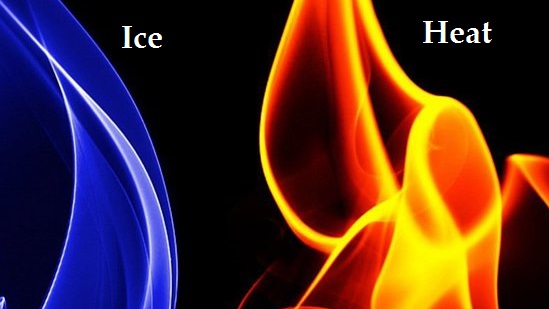When to ice it, and when to use the heating pad!
What ice and heat are for
Ice is for injuries, and heat is for muscles. Roughly.
Ice is for injuries — calming down damaged superficial tissues that are inflamed, red, hot and swollen. The inflammatory process is a healthy, normal, natural process … that also happens to be incredibly painful and more biologically stubborn than it needs to be. Icing is mostly just a mild, drugless way of dulling the pain of inflammation… we hope.1 Examples: a freshly pulled muscle or a new case of IT band syndrome (which is more likely to respond than the other kind of runner’s knee, patellofemoral pain, because ITBS is superficial and PFPS is often a problem with deeper tissues).
Heat is for muscles, chronic pain, and stress — taking the edge off the pain of whole muscle spasms and trigger points, or conditions that are often dominated by them, like back pain and neck pain), for soothing the nervous system and the mind (stress and fear are major factors in many chronic pain problems, of course).
What ice and heat are not for
Heat can make inflammation worse, and ice can make muscle tension and spasms worse, so they have the potential to do some mild harm when mixed up.
Both ice and heat are pointless or worse when unwanted: icing when you’re already shivering, or heating when you’re already sweating. The brain may interpret an excess of either one as a threat — and when brains think there’s a threat, they may also amp up the pain.
But heat and inflammation are a particularly bad combination. If you add heat to an fresh injury, watch out: it’s going to get worse! A physician once told my father to heat a freshly injured knee, and wow — it swelled up like a balloon, three times bigger than it had been before. And three times more painful. (That is a rare example of a particularly severe negative reaction to heat. Most cases are not going to be that bad!)
The lesser known threat is from icing at the wrong time, or when it’s unwanted.
If you ice painful muscles, be careful: it might get worse! Ice can aggravate sensations of muscle pain and stiffness, which are often present in low back and neck pain. Trigger points (painfully sensitive spots) can be surprisingly intense and easily mistaken for “iceable” injury and inflammation. But if you ice trigger points, they may burn and ache even more acutely. This mistake is made particularly often with low back pain and neck pain — the very condition people often try to treat with ice.

